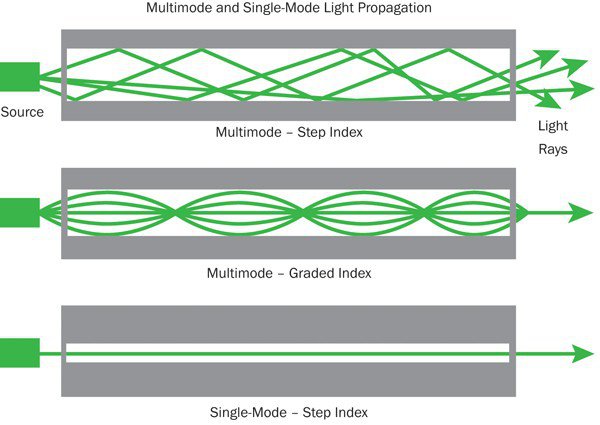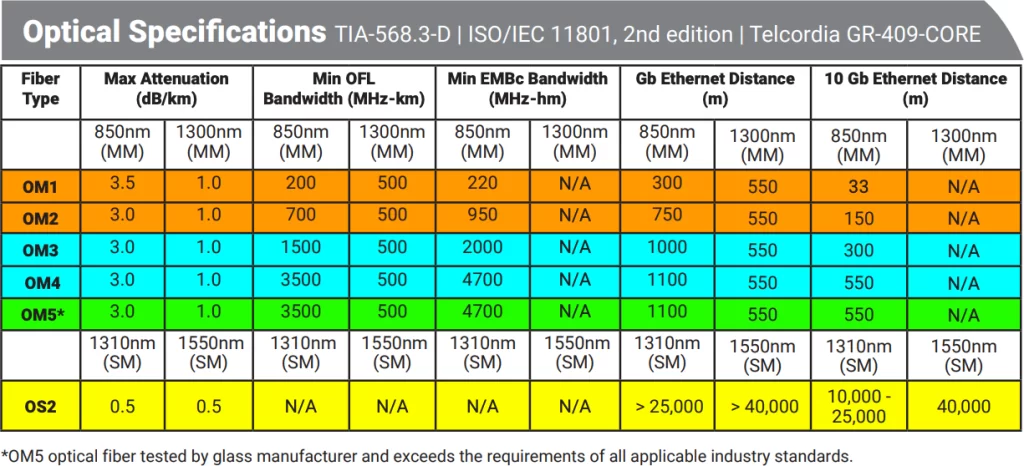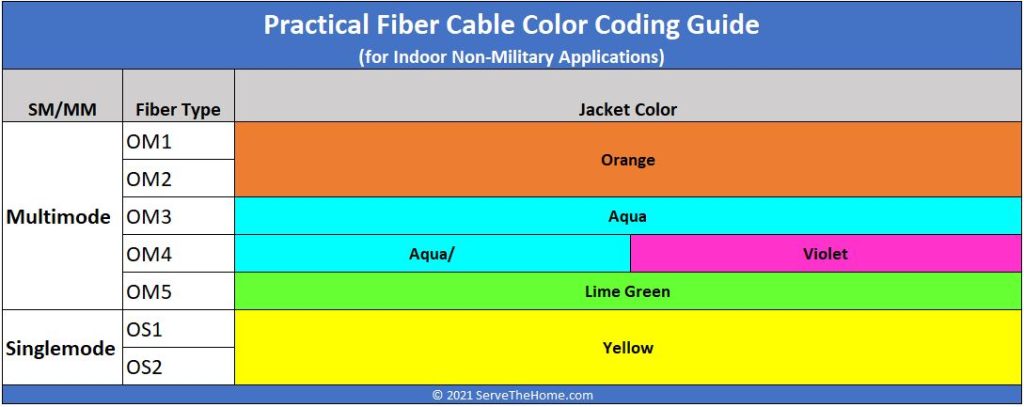MMF multimode fiber—an essential component in modern networking and communication systems. With its ability to support short-distance data transmission efficiently and cost-effectively, multimode fiber plays a crucial role in powering local area networks (LANs), data centers, and enterprise infrastructures.
In this post, You will have answers to the most common questions among users online.

What is multimode fiber?
Multimode fiber is a type of optical fiber that supports the transmission of multiple modes of light through its larger core diameter. It is commonly used for shorter-distance data transmission in LANs, data centers, and enterprise networks due to its lower cost and ease of installation compared to single mode fiber.
How far can multimode fiber go?
Multimode fiber typically supports shorter distances compared to single mode fiber, typically ranging from 300 meters to 2 kilometers depending on the type and quality of the fiber and the transmission speed. Beyond these distances, signal degradation and attenuation become significant, limiting its effectiveness for long-distance transmission.
What is the difference between single mode and multimode fiber?
The primary difference lies in their core diameters and the number of light modes they support. Single mode fiber has a smaller core diameter and supports only one mode of light propagation, enabling long-distance transmission. In contrast, multimode fiber has a larger core diameter and supports multiple light modes, suitable for shorter distances.

Can I use multimode fiber for single mode?
While technically possible, it’s not recommended. Multimode fiber is optimized for shorter distances and operates with different light propagation characteristics than single mode fiber. Using multimode fiber for single mode applications may result in signal loss, increased attenuation, and poor performance over long distances.
Can I use single mode fiber with multimode SFP?
Using single mode fiber with multimode Small Form-factor Pluggable (SFP) modules is not recommended. Single mode SFPs are designed to work with single mode fiber, and using them with multimode fiber may lead to compatibility issues and degraded performance.
Can multimode fiber support 10Gb?
Yes, multimode fiber can support 10 Gigabit Ethernet (10GbE) transmissions, but the distance it can support depends on the type of fiber and the transmission speed. Higher-speed 10GbE transmissions over multimode fiber typically have shorter reach compared to lower-speed transmissions.
Can single mode fiber work with multimode?
While technically possible with special mode conditioning cables or converters, it’s generally not recommended. Mixing single mode and multimode fibers in the same network infrastructure can lead to compatibility issues, increased signal loss, and degraded performance.
Can you mix multimode and single mode fiber?
Mixing multimode and single mode fibers in the same network infrastructure is not recommended due to potential compatibility issues and performance limitations. It’s best to use each type of fiber for its intended purpose and avoid mixing them unless absolutely necessary.
How does multimode fiber work?
Multimode fiber works by allowing multiple modes of light to propagate through its larger core diameter. Each mode takes a different path through the fiber, resulting in dispersion and limiting the distance over which signals can travel effectively.
How to check single mode or multimode fiber?
You can determine the type of fiber by examining its markings, consulting documentation, or using specialized fiber optic testing equipment such as an optical time-domain reflectometer (OTDR) or a light source and power meter.
How to differentiate single mode and multimode fiber?
Single mode and multimode fibers can be differentiated by their core diameters, markings, and color codes. Single mode fiber typically has a smaller core diameter and is labeled with “SMF” or “OS1/OS2,” while multimode fiber has a larger core diameter and is labeled with “MMF” or “OM1/OM2/OM3/OM4/OM5.”

How to terminate multimode fiber?
Multimode fiber can be terminated using various methods such as fusion splicing, mechanical splicing, or connectorization with epoxy or pre-polished connectors. These methods ensure reliable connections for data transmission in multimode fiber networks.
What color is MMF Multimode fiber?
MMF Multimode fiber is typically Orange, although the color may vary depending on manufacturer specifications and industry standards. Yellow-colored jackets are commonly used for single mode fiber cables to distinguish them from multimode fiber cables.

What is the acceptable dB loss for multimode fiber?
The acceptable dB loss for multimode fiber varies depending on the application and industry standards but typically ranges from 2 dB/km to 3 dB/km. This loss includes both intrinsic fiber attenuation and additional losses due to splices, connectors, and other components.
What is the maximum distance of multimode fiber?
The maximum distance of multimode fiber depends on the type of fiber and the transmission speed. Typically, multimode fiber can support distances ranging from 300 meters to 2 kilometers for most applications.
Which 10GbE standard features a multimode fiber type?
The 10 Gigabit Ethernet (10GbE) standard features a multimode fiber type commonly referred to as 10GBASE-SR. This standard is suitable for short-distance transmissions over multimode fiber within data centers and LAN environments.
Which is better single mode or multimode fiber?
The choice between single mode and multimode fiber depends on the specific requirements of the application. Single mode fiber is ideal for long-distance transmission and high-speed data rates, while multimode fiber is suitable for shorter distances and lower-cost installations.
Why use multimode fiber?
Multimode fiber is preferred for short-distance data transmission in LANs, data centers, and enterprise networks due to its lower cost and ease of installation compared to single mode fiber. It’s suitable for applications where high-speed, long-distance transmission is not required.
What is multimode step index fiber?
Multimode step index fiber is a type of multimode fiber where the refractive index of the core decreases stepwise from the center towards the outer cladding. This design allows multiple light modes to propagate through the fiber, enabling short-distance data transmission in LANs and other applications.
Which statement is correct about multimode fiber?
Multimode fiber supports the transmission of multiple light modes through its larger core diameter, making it suitable for short-distance data transmission in LANs, data centers, and enterprise networks. However, it has limitations in terms of distance and bandwidth compared to single mode fiber.
Conclusion
For more questions about multimode fiber, You can request us and we will keep it updated. If you are looking for fiber optic products with multimode fiber, such as Multimode fiber pigtails, Multimode fiber patch cords, Multimode fiber cables , Bativ will be one of your best suppliers in China.
Discover Fiber Optic Solution for Your Business with Bativ
Whether you need single mode or multimode fiber optic products, work with an experienced fiber optic connectivity company like bativ. We can deliver high-quality mmf fiber pigtails, fiber patch cables, plc splitters, fiber splice closures and more.
We’ll guide you on the best types of material and products for your needs and budget. we’re here to help. Get in touch today to discuss your requirements.